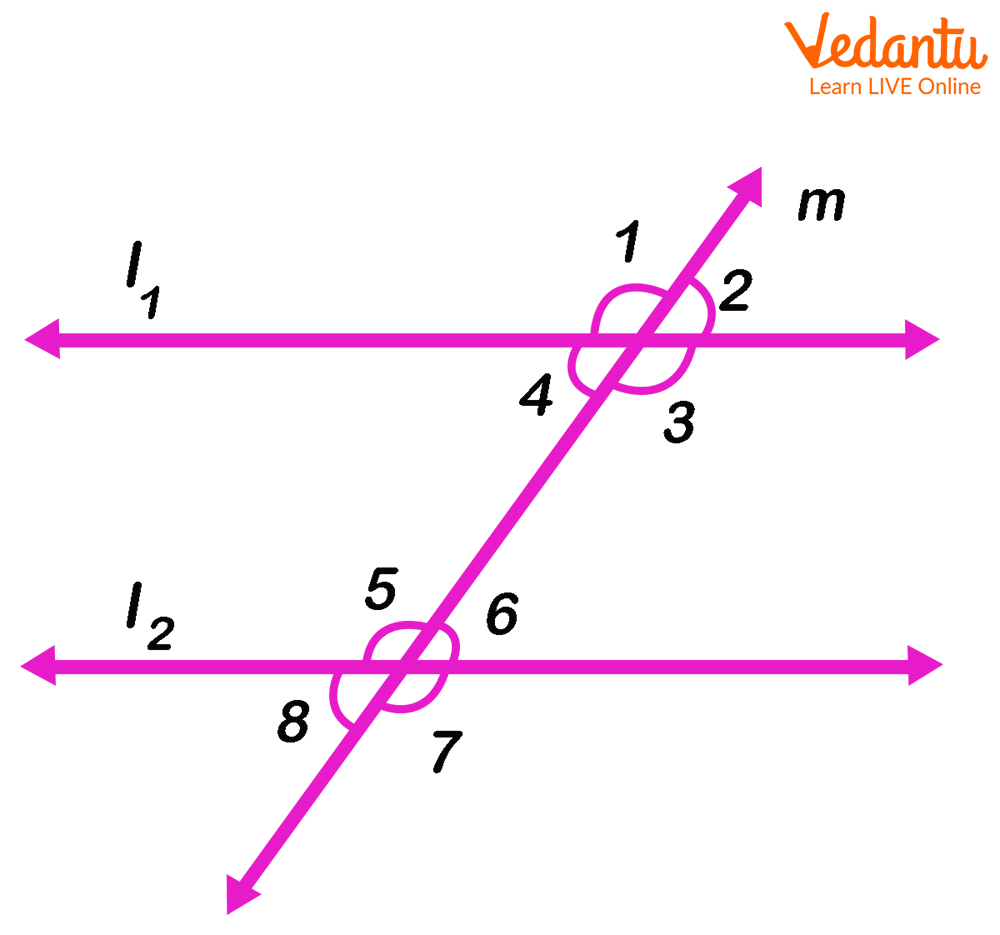




Parallel lines are straight lines that are equidistant from each other and have the same slope. So, when two or more lines do not meet at any point, we call them parallel.
Just observe the section-wise lines of each class during the morning assembly, you notice that these lines are at some distance from each other and they don’t meet at any point. This arrangement shows that lines are parallel, also, these lines meet at nowhere or infinity.
So, what other characteristics do parallel lines hold? Also, how do we categorise the properties of lines with the help of transversal lines, we will understand all about it in detail.
Parallel Lines and Transversal Lines
When a line intersects any two parallel lines, we call it a transversal. In this arrangement, many pairs of angles are formed. Among these, some angles are congruent (equal) while others are supplementary.
Now, let us observe the following figure to see the parallel lines labelled as l1 and l2 that intersect by a transversal:

Parallel Lines
In this figure, eight separate angles have been formed by the two parallel lines and a transversal. Each angle has been labelled using numbers.
Corresponding Angles:
In the given figure, there are four pairs of corresponding angles, that is, ∠1 = ∠5, ∠2 = ∠6, ∠4 = ∠8, and ∠3 = ∠7.
Alternate Interior Angles:
Angles that formed on the inside of two parallel lines that are intersected by a transversal are alternate interior angles. They are equal in measure. In this figure, ∠4 = ∠6 and ∠3 = ∠5.
Alternate Exterior Angles:
Alternate exterior angles are formed on either side of the transversal and they are equal in measure. In this figure, ∠1 = ∠7 and ∠2 = ∠8.
Consecutive Interior Angles:
Consecutive interior angles or co-interior angles are formed on the inside of the transversal and they are supplementary. Here, ∠3 + ∠6 = 180° and ∠4 + ∠5 = 180°.
Vertically Opposite Angles:
Angles formed when two straight lines intersect each other and they are equal in measure, we call them vertically opposite angles. Here, ∠1 = ∠3, ∠2 = ∠4, ∠5 = ∠7, and ∠6= ∠8.
Parallel lines Equation
The equation of a straight line is written in the slope-intercept form represented by the following equation:
y = mx + b
Here, 'm' is the slope and 'b' is the y-intercept.
Please note that the value of 'm' determines the slope or gradient and tells us how steep the line is. Also, it should be noted that the slope of any two parallel lines is always the same.
Assume that the slope of a line with the equation y = 4x + 3 is 4. Thus, any line that is parallel to y = 4x + 3 will also have the same slope, that is, 4.
We must remember that parallel lines have different y-intercepts and have no points in common.
Which Lines Appear to be Parallel?
Apart from the characteristics of parallel lines given above, when any two parallel lines are intersected by a transversal, we can understand the lines that appear to be parallel by the following properties:
Two lines are parallel when the corresponding angles so formed are equal.
Two lines are parallel when the alternate interior angles so formed are equal.
Two lines are parallel when the alternate exterior angles so formed are equal.
Two lines are parallel when the consecutive interior angles on the same side of the transversal are supplementary.
From the above text, we understand that parallel lines are equidistant and meet at infinity. Also, all the lines parallel to them will have the same slope, i.e., m.
FAQs on Characteristics of Parallel Lines
1. What are the properties of parallel lines?
Parallel lines can be easily recognised with the following basic properties:
These are straight lines having the same distance apart from each other.
These lines never meet no matter how much they are extended in either direction.
2. How do we symbolise parallel lines?
Parallel lines are denoted by a symbol ||. For example, CD || PQ indicates that line CD is parallel to line PQ.
3. What is a line in lines and angles?
A line is a row of closely spaced dots that lengthen infinitely in two directions. It has only one dimension, i.e., its length. We can consider a line as a horizontal mark drawn on a piece of paper while an angle is a figure created by two rays that meet at a common endpoint.











